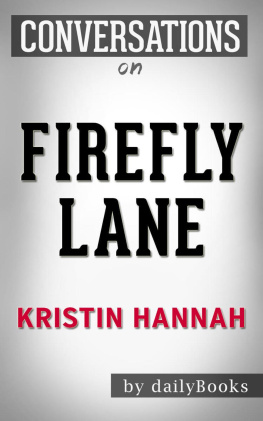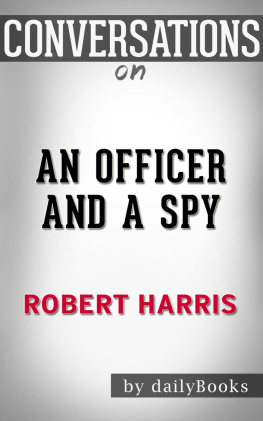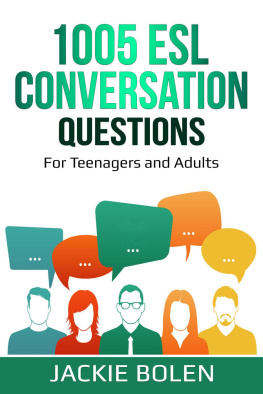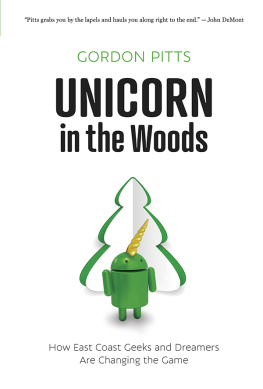Table of Contents
1,000 Conversation Questions: Designed for Use in the ESL or EFL Classroom
Copyright 2016 by Larry Pitts
All rights reserved. This book or any portion thereof may not be reproduced or used in any manner whatsoever without the express written permission of the publisher except for the use of brief quotations in a book review.
Discussion questions were used with the permission of ESL Conversation Questions
www.eslconversationquestions.com
Published by ECQ Publishing
ISBN-13: 978-1-942116-00-4
ACKNOWLEDGMENTS
There are a few people I would like to thank for their help in getting me to the point where I could write this book.
First of all, I would like to thank my parents, Larry and Lona, and my brother Wesley. Without their love, infinite patience, guidance, and understanding I would have never made it as far as I have.
I want to thank my wife for her encouragement and love throughout all my successes and failures.
I would also like to thank all of my fellow teachers who have kept me sane through the hard times and celebrated with me during the good times.
Lastly, I want to thank all of my students who have made my years of teaching fun and interesting.
USING CONVERSATION QUESTIONS IN THE CLASSROOM
Let me begin by saying, these tips on how to use conversation questions in the classroom are based on what I have found to work in my classes. You may have to tweak or disregard some of my advice to accommodate your own teaching style. With that in mind, lets get started.
Timing
First, lets talk about how much time to allocate for questions. When planning lessons, I most often follow a rough rule of a minimum of one minute per question and a maximum of three minutes per question. That doesnt really indicate how much time they will spend on each individual question; its just a rough estimate for judging the amount of time it will take to finish a set of questions.
So, if you give your students ten questions, youll burn between ten to thirty minutes of class time. Now of course this isnt a steadfast rule. There will always be exceptions. All things considered though, about twenty minutes for ten questions is the average for my classes.
Another quick point, if you can limit how many questions they see at a time (using PowerPoint or spaced handouts) they will answer questions more fully and take more time. I find showing them five questions at a time makes for a good pace.
Group size
Next, you need to decide how many students to put into each group. As a general rule of thumb I find that three students in a group is the ideal number. I say this because with three students everyone gets a good chance to talk, but there are still enough people to have a rich reservoir of ideas to discuss.
Two students really maximize talking time, but often the two students dont get along or you might have two shy students that end up together.
Four students can work, but often there isnt enough talk time for each student and shy students feel like they are on stage every time they talk.
Five students in a group are far too many and often they just wont talk. All this being said, ultimately it comes down to the dynamics of your class and its size.
If you have a really talkative class with a good dynamic, putting them in pairs works well. Groups of four generally work best with groups of shy students, because they feel more pressure to speak if everyone in the group is silent.
Mistakes are okay
Assure your students that mistakes are okay. If they arent making mistakes, they arent trying hard enough. Tell them that you are happy when they make mistakes because that means they are trying new and difficult ways of saying things. If they dont make any mistakes then they havent learned anything.
One thing to stress is that they shouldnt be speaking their native language. It is better to say something that is incorrect or unclear in English than correctly and clearly in their first language.
Let the conversation flow
Another important point to stress is that they are free to discuss more than just the questions. In a natural conversation the topic moves from one subject to another; this is what you want in your classes as well. Very often students will treat questions like an ordered set of goals to accomplish. Let them know if they dont discuss them all, thats okay!
If they spend the whole time talking about just one question, that is great. It means they are having a natural conversation. Just make sure they are speaking only in English! I tell my students that they can discuss whatever questions they think are interesting. If they dont think any questions are interesting, they should make their own questions.
I let them know that I dont care what they talk about, as long as they speak in English. Now that isnt totally true, I do care about what they talk about, and I target my questions to accomplish certain goals in the class. But I want them to feel free enough to branch off into a natural conversation. I would say 99% of the time they just use the questions that I give them. How about the other 1%? Well at least they are speaking English, and they usually get to the questions eventually.
Keep out of the discussion
After you have put the students into groups and they are talking, there is one important point to remember. Stay out of the discussion! I know it may be tempting to make a comment, but this is their time to discuss.
The only time you should be interrupting their discussion is when they ask you for help. Sometimes you can interject with a vocabulary word if they are searching for the perfect word or if they are using a vocabulary word incorrectly over and over again. Otherwise, stay out of the discussion. So what are you doing while they are discussing? You are monitoring each groups discussion and taking notes.
Take notes
While you are monitoring your students discussions, you should be taking notes. Take note of any errors that are being made repeatedly (i.e., errors in grammar, pronunciation, or vocabulary use). Write down some specific sentences that contain common errors you hear or that contain errors you wish to work on.
Decide which errors or mistakes would be useful to go over with the class and at the end of class or at the end of the discussion, go over some of these mistakes and errors. When you go over the errors, keep them anonymous and let students know that its a good thing if they see their mistake on the board. You might let the class try to correct the errors or correct them yourself for the class depending on how much time you have.
So, those are the tips I have for using conversation questions in an adult ESL class. You may find that these tips dont suit your teaching style. Give them a try and if they dont mesh with your teaching style, try something different. Every teacher teaches differently and every student learns differently. Ultimately the goal is to find what works best for you and your class.
EXTRAS
There are a couple of extras I want to let you know about before you get into the questions.
Bonus questions and topics
The title would have you believe that there are 1000 questions in this book, but the truth is there are actually more than that. There is actually a grand total of 1436 questions spanning 134 topics in this book. Enjoy the extra topics and questions!
Bounty for errors













